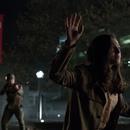The Eerie Familiarity of “Man in the High Castle”
The Man in the High Castle, the Emmy Award winning TV series, imagines a world in which the Nazi’s won WWII. Set in the 1960s, the show blends actual pop cultural imagery and artifacts with fictional interpretations of an alternative ending to the war.
When its first season debuted, the show’s ad campaign in New York City subways hit a little too close to home. And the show’s second season, which dropped last week, is resonating in a similar way, although this time not so intentionally, just as white nationalists gain exposure in the lead-up to the Trump presidency. “But if it would be hyperbole to treat the series like a documentary, it would be denial to say it plays no differently now than it did before,” says James Poniewozik the chief television critic for The New York Times. He joined Kurt in the studio to talk about his most recent article on the series which points to the parallels between fiction and reality.
